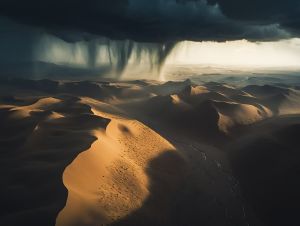Climate of Zanarak
The Climate of Zanarak is one of unforgiving extremes, where scorching days, freezing nights, and violent storms shape the lives of those who call the desert home. Unlike many realms of Adaris, Zanarak does not experience traditional seasons—instead, it endures cycles of drought, shifting sands, and unpredictable mirages.
Temperature Extremes
| Condition | Daytime | Nighttime |
|---|---|---|
| Average Temperature | 50°C (122°F) | -5°C (23°F) |
Zanarak’s vast dunes and glass-laden landscapes absorb heat rapidly during the day, but with no moisture to trap warmth, the desert becomes bitterly cold at night.
Daytime Heat
- The average midday temperature in the heart of Zanarak exceeds survivable levels, forcing most creatures to seek shelter underground or within shaded structures. - The Glass Fields and Borderlands of Ash are even hotter, where exposed metal or stone can burn flesh within seconds. - Travelers move only at dawn or dusk, and settlements rely on thick walls, subterranean dwellings, and heat-reflecting architecture to survive.
Freezing Nights
- As soon as the sun sets, the heat rapidly escapes, and the temperature can plummet below freezing in some regions. - Cold-resistant plants and creatures have adapted to the extreme shift, while desert dwellers rely on layered clothing and heat-retaining structures to endure the cold.
Weather & Atmospheric Conditions
Zanarak’s storms are as deadly as its heat, bringing blinding winds, razor-sharp glass, and sudden burial beneath the dunes.
Sandstorms
- Unpredictable and frequent, these storms can reduce visibility to nothing and strip flesh from bone in the worst cases. - Some storms last only minutes, while others can rage for days, reshaping the landscape entirely. - Nomads and caravans rely on storm-sensing rituals and old paths to predict when it is safe to travel.
Glassstorms
- A rare but lethal phenomenon unique to the Glass Fields of Zanarak. - Wind carries fragments of razor-sharp glass, turning the air into a whirling deathtrap. - Even seasoned Gilaari miners refuse to work during a glassstorm, retreating into shelters carved into stone or sand dunes.

Drought Cycles
- Rain is extremely rare in Zanarak, often not falling for years at a time. - When rain does come, it is often violent and brief, forming temporary oases that quickly vanish. - Some settlements, like Mirajhar, are rumored to have hidden wells or knowledge of underground water sources.
Unique Weather Phenomena
Beyond its deadly heat and storms, Zanarak experiences rare, mysterious atmospheric events, shaping both myth and survival strategies among its inhabitants.
Mirage Season
- Occurring at the peak of Zanarak’s heat cycle, when air distortions become strongest. - Entire phantom cities, illusory lakes, and shifting landmarks appear, luring travelers to their doom or to hidden truths. - Some Sunshifters claim that during this season, one can see visions of the past and future in the shimmering dunes.
The Sunveil Effect
- A phenomenon near the Glass Fields, occurring when the sun strikes the translucent spires at the perfect angle. - The desert glows like liquid gold, turning the entire region into a blinding, dreamlike expanse of endless light. - Travelers caught in this suffer extreme disorientation, and some believe it to be a divine test from Arenam.
Fire Rains (Rare Ashfall)
- When the volcanoes of Tahr’Zul erupt, fine volcanic ash drifts over Zanarak, coating the dunes in a thin layer of black dust. - This chokes the air, making breathing difficult, but also fertilizes rare desert plant life that blooms briefly before dying.
Lightning Dunes
- During certain charged sandstorms, the friction of the winds generates static discharges. - This causes blue-white arcs of lightning to dance across the dunes, creating an eerie and beautifully dangerous sight. - Some Sunshifters believe these storms charge mirage glass with latent power, making these storms highly sought after by desert alchemists.
Impact on Settlements & Survival
To endure Zanarak’s climate, settlements and travelers must adapt in clever and resourceful ways.
Architecture & Shelter
- Buildings are often half-buried in the sand to retain cool air and provide insulation against freezing nights. - Glass and obsidian reinforcements protect structures from sandstorms and glassstorms. - Mirrored rooftops and white stone walls help deflect heat away from dwellings.
Travel & Survival Strategies
- Movement is timed—caravans travel only at dawn or dusk to avoid heatstroke. - Water is life—traders value fresh water above gold, and settlements closely guard their wells. - Protective clothing—travelers wear loose, layered fabrics to trap cool air and block the sun.
"The Desert Burns, the Desert Freezes, the Desert Remains"
A saying among the desert dwellers of Zanarak, symbolizing the unyielding nature of the sands—to survive here, one must be as adaptable as the shifting dunes themselves.